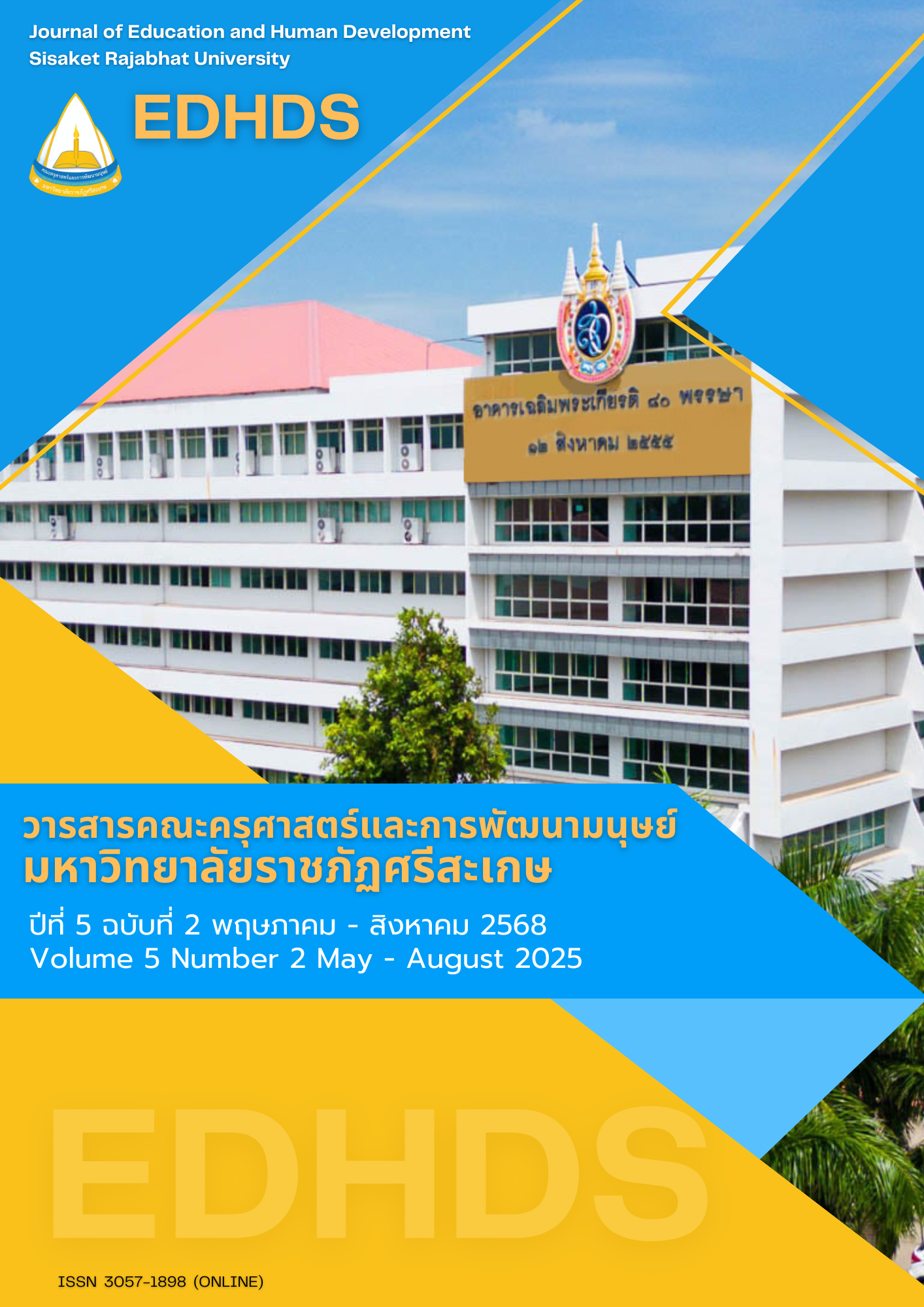การแนะแนวบนฐานความต้องการจำเป็นของผู้เรียน: การแปลผลวิจัยสู่การปฏิบัติที่เข้าใจผู้เรียน
คำสำคัญ:
ความต้องการจำเป็นของผู้เรียน, การแนะแนว, เสียงจากภายในบทคัดย่อ
ความต้องการจำเป็นของผู้เรียนในระบบการศึกษาไทยยังไม่ได้รับการตอบสนองอย่างลึกซึ้ง โดยเฉพาะด้านการจัดการอารมณ์ การได้รับความเข้าใจจากครูและการเคารพในศักดิ์ศรี บทความนี้มุ่งวิเคราะห์ "ความต้องการจำเป็น" ของผู้เรียนที่สะท้อนผ่านผลวิจัยของสำนักงานเลขาธิการสภาการศึกษา ปี 2568 โดยตีความว่าเป็น "เสียงจากภายใน" ที่ซ่อนอยู่ภายใต้ความเงียบและความท้าทายในการแสดงออก การศึกษาใช้วิธีวิเคราะห์เอกสารเชิงบูรณาการร่วมกับทฤษฎีจิตวิทยาและการแนะแนว ได้แก่ ทฤษฎีการกำหนดตนเอง การพัฒนาเยาวชนเชิงบวก การดูแลโดยเข้าใจภาวะบาดแผล และทฤษฎีความบังเอิญที่วางแผนไว้ ผลการวิเคราะห์เสนอกรอบแนวคิด "Voice-to-Action Framework" ซึ่งช่วยถอดรหัสความต้องการเชิงลึกของผู้เรียนเป็น 3 ระดับ คือ ผิวเผิน การตีความ และเสียงจากภายใน พร้อมแนวทางการแนะแนวเชิงตอบสนองในระดับกิจกรรมกลุ่ม การให้คำปรึกษารายบุคคล และระดับเชิงระบบ เพื่อส่งเสริมการเติบโตอย่างยั่งยืนและมีความหมาย
เอกสารอ้างอิง
กรมสุขภาพจิต. (2568). รายงานประจำปีกรมสุขภาพจิต ประจำปีงบประมาณ พ.ศ. 2567. กระทรวงสาธารณสุข.
สำนักงานเลขาธิการสภาการศึกษา. (2568). รายงานผลการวิจัยระดับชาติว่าด้วยคุณภาพชีวิตและความต้องการของผู้เรียน. สำนักงานเลขาธิการสภาการศึกษา.
Archambault, I., Janosz, M., Fallu, J.-S., & Pagani, L. S. (2009). Adolescent school dropout: A review of psychological and educational predictors. Educational Psychology Review, 21(2), 131–145. https://doi.org/10.1007/s10648-008-9090-0
Bronfenbrenner, U. (1979). The ecology of human development: Experiments by nature and design. Harvard University Press.
Chung, J. H. J. (2021). “We participate, silently”: Thai university students’ perceptions of classroom participation. Qualitative Research in Education, 10(1), 62–87. https://doi.org/10.17583/qre.2021.6018
Krumboltz, J. D. (2009). The happenstance learning theory. Journal of Career Assessment, 17(2), 135–154. https://doi.org/10.1177/1069072708328861
Lerner, R. M., Almerigi, J. B., Theokas, C., & Lerner, J. V. (2005). Positive youth development: A view of the issues. The Journal of Early Adolescence, 25(1), 10–16. https://doi.org/10.1177/0272431604273211
National Child Traumatic Stress Network. (2017). Creating, supporting, and sustaining trauma-informed schools: A systems framework. https://www.nctsn.org/resources/creating-supporting-and-sustaining-trauma-informed-schools-systems-framework
Przybylski, A. K., Murayama, K., Roecklein, C. M., & Ryan, R. M. (2013). Motivational, emotional, and behavioral correlates of fear of missing out. Motivation and Emotion, 37(2), 181–188. https://doi.org/10.1007/s11031-013-9313-2
Robinson, K., & Aronica, L. (2015). Creative schools: The grassroots revolution that's transforming education. Viking.
Rogers, C. R. (1961). On becoming a person: A therapist's view of psychotherapy. Houghton Mifflin.
Ryan, R. M., & Deci, E. L. (2017). Self-determination theory: Basic psychological needs in motivation, development, and wellness. Guilford Press.
Sugai, G., & Horner, R. H. (2009). Responsiveness-to-intervention and school-wide positive behavior supports: Integration of multi-tiered system approaches. Exceptionality, 17(4), 223–237. https://doi.org/10.1080/09362830903235375
Twenge, J. M. (2017). iGen: Why today's super-connected kids are growing up less rebellious, more tolerant, less happy and completely unprepared for adulthood and what that means for the rest of us. Atria Books.
Valkenburg, P. M., & Peter, J. (2017). Social media and adolescents' well-being: Developing a process model of various risk and opportunity effects. Journal of Youth and Adolescence, 46(5), 920–938. https://doi.org/10.1007/s10964-017-0649-z
ดาวน์โหลด
เผยแพร่แล้ว
รูปแบบการอ้างอิง
ฉบับ
ประเภทบทความ
สัญญาอนุญาต
ลิขสิทธิ์ (c) 2025 คณะครุศาสตร์และการพัฒนามนุษย์ มหาวิทยาลัยราชภัฏศรีสะเกษ

อนุญาตภายใต้เงื่อนไข Creative Commons Attribution-NonCommercial-NoDerivatives 4.0 International License.
บทความที่ได้รับการตีพิมพ์เป็นลิขสิทธิ์ของคณะครุศาสตร์และการพัฒนามนุษย์ มหาวิทยาลัยราชภัฏศรีสะเกษ
ข้อความที่ปรากฏในบทความแต่ละเรื่องในวารสารวิชาการเล่มนี้เป็นความคิดเห็นส่วนตัวของผู้เขียนแต่ละท่านไม่เกี่ยวข้องกับมหาวิทยาลัยราชภัฏศรีสะเกษ และคณาจารย์ท่านอื่นๆในมหาวิทยาลัยฯ แต่อย่างใด ความรับผิดชอบองค์ประกอบทั้งหมดของบทความแต่ละเรื่องเป็นของผู้เขียนแต่ละท่าน หากมีความผิดพลาดใดๆ ผู้เขียนแต่ละท่านจะรับผิดชอบบทความของตนเอง



